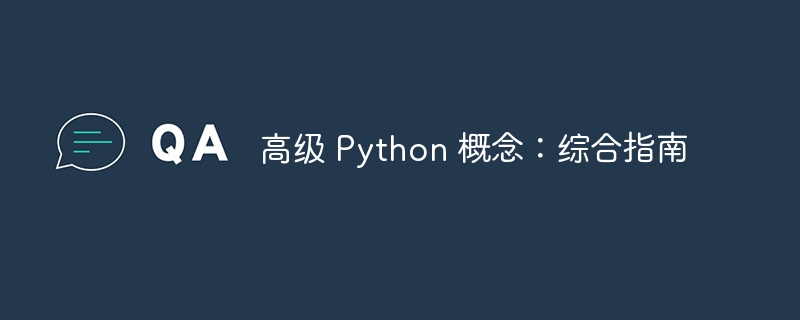高级 Python 概念:综合指南

python 是一种多功能且强大的编程语言,提供广泛的高级功能。本白皮书探讨了四个关键的高级概念:装饰器、生成器和迭代器、上下文管理器和元类。这些功能使开发人员能够编写更高效、可读和可维护的代码。虽然这些概念乍一看可能很复杂,但理解和利用它们可以显着提高您的 python 编程技能。
装饰器是一种强大而灵活的方法,可以修改或增强函数或类,而无需直接更改其源代码。它们本质上是接受另一个函数(或类)作为参数并返回该函数(或类)的修改版本的函数。
使用装饰器的基本语法是:
@decorator_function
def target_function():
pass
这相当于:
def target_function():
pass
target_function = decorator_function(target_function)
让我们创建一个简单的装饰器来记录函数的执行:
def log_execution(func):
def wrapper(*args, **kwargs):
print(f"executing {func.__name__}")
result = func(*args, **kwargs)
print(f"finished executing {func.__name__}")
return result
return wrapper
@log_execution
def greet(name):
print(f"hello, {name}!")
greet("alice")
输出:
executing greet hello, alice! finished executing greet
装饰器也可以接受参数。这是通过添加另一层功能来实现的:
def repeat(times):
def decorator(func):
def wrapper(*args, **kwargs):
for _ in range(times):
result = func(*args, **kwargs)
return result
return wrapper
return decorator
@repeat(3)
def say_hello():
print("hello!")
say_hello()
输出:
hello! hello! hello!
装饰器也可以应用于类:
def singleton(cls):
instances = {}
def get_instance(*args, **kwargs):
if cls not in instances:
instances[cls] = cls(*args, **kwargs)
return instances[cls]
return get_instance
@singleton
class databaseconnection:
def __init__(self):
print("initializing database connection")
# this will only print once, even if called multiple times
db1 = databaseconnection()
db2 = databaseconnection()
装饰器是一个强大的工具,可以在不改变现有代码结构的情况下修改行为并向其添加功能。
生成器和迭代器是 python 中强大的功能,可以有效处理大型数据集并创建自定义迭代模式。
迭代器是一个可以迭代(循环)的对象。它表示数据流并一次返回一个元素。在python中,任何实现了 __iter__() 和 __next__() 方法的对象都是迭代器。
class countdown:
def __init__(self, start):
self.count = start
def __iter__(self):
return self
def __next__(self):
if self.count
<p>输出:<br></p>
<pre class="brush:php;toolbar:false">4
3
2
1
0
生成器是使用函数创建迭代器的简单方法。生成器不使用 return 语句,而是使用 yield 来生成一系列值。
def fibonacci(n):
a, b = 0, 1
for _ in range(n):
yield a
a, b = b, a + b
for num in fibonacci(10):
print(num, end=" ")
输出:
0 1 1 2 3 5 8 13 21 34
生成器表达式是一种创建生成器的简洁方法,类似于列表推导式,但使用括号而不是方括号:
squares = (x**2 for x in range(10)) print(list(squares))
输出:
[0, 1, 4, 9, 16, 25, 36, 49, 64, 81]
生成器具有内存效率,因为它们即时生成值,而不是一次将它们全部存储在内存中。
上下文管理器提供了一种便捷的资源管理方式,确保正确获取和释放文件句柄或网络连接等资源。
使用上下文管理器的最常见方法是使用 with 语句:
with open('example.txt', 'w') as file:
file.write('hello, world!')
这可以确保文件在写入后正确关闭,即使发生异常。
您可以通过实现 __enter__() 和 __exit__() 方法来创建自己的上下文管理器:
class databaseconnection:
def __enter__(self):
print("opening database connection")
return self
def __exit__(self, exc_type, exc_value, traceback):
print("closing database connection")
def query(self, sql):
print(f"executing sql: {sql}")
with databaseconnection() as db:
db.query("select * from users")
输出:
opening database connection executing sql: select * from users closing database connection
contextlib 模块提供了用于使用上下文管理器的实用程序,包括 @contextmanager 装饰器:
from contextlib import contextmanager
@contextmanager
def tempdirectory():
print("creating temporary directory")
try:
yield "temp_dir_path"
finally:
print("removing temporary directory")
with tempdirectory() as temp_dir:
print(f"working in {temp_dir}")
输出:
creating temporary directory working in temp_dir_path removing temporary directory
上下文管理器有助于确保资源得到正确管理和清理,降低资源泄漏的风险并使代码更加健壮。
元类是类的类。它们定义类的行为和创建方式。虽然元类在日常编程中并不常用,但它可以成为创建 api 和框架的强大工具。
在python中,对象的类型是类,类的类型是元类。默认情况下,python 使用类型元类来创建类。
class myclass:
pass
print(type(myclass)) # <class></class>这是一个简单的元类的示例,它将类属性添加到它创建的所有类中:
class addclassattribute(type):
def __new__(cls, name, bases, dct):
dct['added_attribute'] = 42
return super().__new__(cls, name, bases, dct)
class myclass(metaclass=addclassattribute):
pass
print(myclass.added_attribute) # 42
元类可以用来实现设计模式,比如单例模式:
class singleton(type):
_instances = {}
def __call__(cls, *args, **kwargs):
if cls not in cls._instances:
cls._instances[cls] = super().__call__(*args, **kwargs)
return cls._instances[cls]
class database(metaclass=singleton):
def __init__(self):
print("initializing database")
# this will only print once
db1 = database()
db2 = database()
print(db1 is db2) # true
python中的abc模块使用元类来实现抽象基类:
from abc import ABC, abstractmethod
class Animal(ABC):
@abstractmethod
def make_sound(self):
pass
class Dog(Animal):
def make_sound(self):
return "Woof!"
# This would raise an error:
# animal = Animal()
dog = Dog()
print(dog.make_sound()) # Woof!
元类是一个强大的功能,允许您自定义类的创建和行为。虽然大多数编程任务不需要它们,但了解元类可以让您更深入地了解 python 的对象系统,并且对于创建高级框架和 api 很有用。
本白皮书探讨了四个高级 python 概念:装饰器、生成器和迭代器、上下文管理器和元类。这些功能为编写更高效、可读和可维护的代码提供了强大的工具。虽然一开始看起来很复杂,但掌握这些概念可以显着提高您的 python 编程技能,并为您的软件开发项目开辟新的可能性。
请记住,虽然这些高级功能很强大,但应谨慎使用它们。清晰、简单的代码通常比过于聪明的解决方案更可取。与编程的各个方面一样,关键是使用正确的工具来完成工作,并始终优先考虑代码的可读性和可维护性。
以上就是高级 Python 概念:综合指南的详细内容,更多请关注php中文网其它相关文章!
 《无所畏惧》温莉的结局是什么
时间:2023-11-25
《无所畏惧》温莉的结局是什么
时间:2023-11-25
 《无所畏惧》刘铭的结局是什么
时间:2023-11-25
《无所畏惧》刘铭的结局是什么
时间:2023-11-25
 《无所畏惧》罗英子和陈硕最后在一起了吗
时间:2023-11-25
《无所畏惧》罗英子和陈硕最后在一起了吗
时间:2023-11-25
 《宁安如梦》 姜雪宁是如何设计让薛姝去和亲
时间:2023-11-25
《宁安如梦》 姜雪宁是如何设计让薛姝去和亲
时间:2023-11-25
 《宁安如梦》薛姝为了不和亲做了什么
时间:2023-11-25
《宁安如梦》薛姝为了不和亲做了什么
时间:2023-11-25
 《宁安如梦》为什么姜雪蕙只能当侧妃
时间:2023-11-25
《宁安如梦》为什么姜雪蕙只能当侧妃
时间:2023-11-25